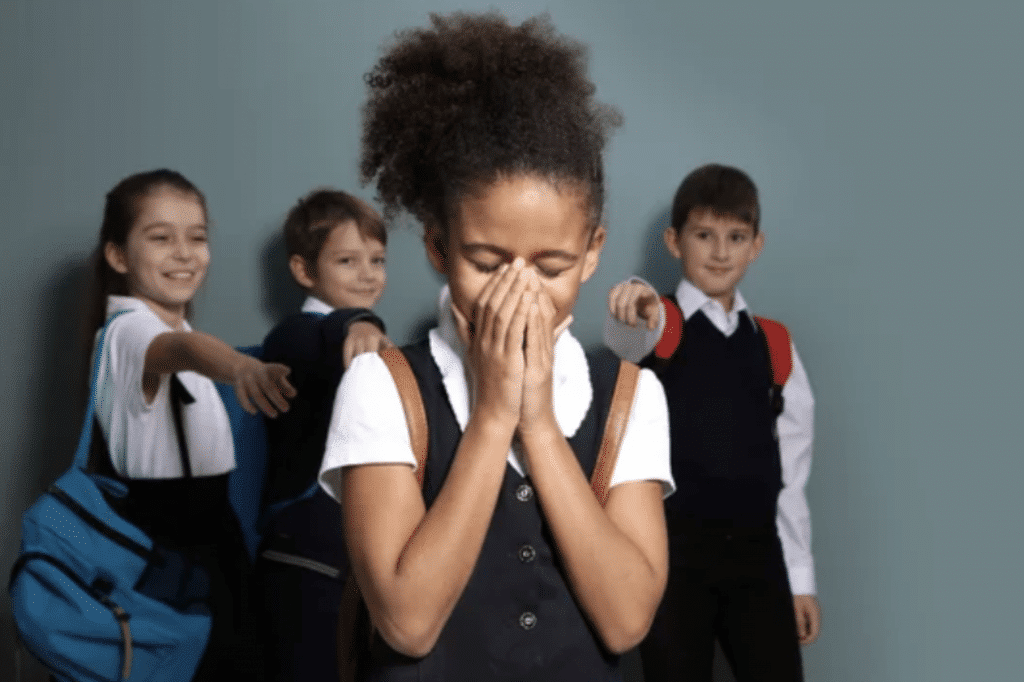Is My Child a Bully?
Know when your child is bullying others, understand the causes, and help them get back on track
NOV 17, 2021
Is My Child a Bully?
Know when your child is bullying others, understand the causes, and help them get back on track
As a parent, it can be devastating when you find out that your child has bullied a classmate. Feelings of dismay, confusion, and shame are typical. It’s important to remember that the school is ready to support your family. Administrators and teachers share your goal for your child to be safe, happy, and thriving.

For decades bullying has been dismissed as normal childhood behavior explained away by the adage “kids will be kids.” Current research shows that bullying is not a healthy part of childhood development. “It should not be considered a normal part of the typical social grouping that occurs throughout an individual’s life” (Sarzosa, 2020). Its prevalence is concerning, with 19% of students in grades 9-12 reporting bullying on school grounds (Assistant Secretary for Public Affairs, 2021).
It’s vital to recognize when a child is at risk of becoming a bully. See the signs indicating a current problem, discover the motivations, and become equipped to help your child move past this aggression. Fortunately, there are multiple resources available to help support your family.
Types of Bullying
Bullying has been categorized into four subsets: physical, verbal, relational, and cyberbullying. Physical bullying involves shoving, kicking, and hitting. Threats and name-calling are hallmarks of verbal bullying. Instigating gossip or excluding others from a social group indicates relational bullying. Finally, cyberbullying uses electronic means to harass, extort, or intimidate others (Stubbs-Richardson, 2021).
Cyberbullying

As parents, educators, and caregivers, try to identify risks, recognize troubling behavior, discover and address core issues, and guide the child who is engaging in cyberbullying to discontinue the aggression and make amends.
Practitioners and intervention specialists should be aware of the relationship between traditional bullying and cyberbullying (Paul, Smith, & Blumberg, 2012) and that the risk of youth being involved in cyberbullying is greater if they are frequently involved in bullying at school.
—Dr. Robin M. Kowalski, Professor of Psychology, Clemson University
Risk Factors of Becoming a Bully
A traditional bully
Children who have bullied others in traditional ways are more likely to participate in cyber aggression (Ybarra, 2004). Practitioners and intervention specialists need to be aware of the relationship between traditional bullying and cyberbullying (Paul, Smith, & Blumberg, 2012) and that the risk of youth participating in cyberbullying increases if they are repeatedly bullied at school (Kowalski, R. M., 2012).
Bullied victim history
Cyberbullies may have been the victims of bullying currently or in the past. They often act out to assert the feeling of control lost by their own experience as a target. Children are not mature enough to see themselves entwined in a cycle of abuse. They cannot typically see the dysfunction. From their trauma, they may equate power with fear.
A typical bully has trouble resolving problems with others and also has trouble academically, usually has negative attitudes and beliefs about others, feels negatively toward himself/herself, comes from a family environment characterized by conflict …, perceives school as negative, and is negatively influenced by peers.
—American Psychological Association
Trait Characteristics & Experience
Young people who struggle with honesty and lack humility, agreeableness, and conscientiousness are more at risk to commit crimes (Farrell, 2017). Children who have witnessed violence are at higher risk, and those who have used drugs or alcohol are more likely to bully than their peers (Pickering, 2011). “A typical bully has trouble resolving problems with others and also has trouble academically; usually has negative attitudes and beliefs about others, feels negatively toward himself/herself, comes from a family environment characterized by conflict …., perceives school as negative, and is negatively influenced by peers” (American Psychological Association, 2010).
Bullies also exhibit negative attitudes toward others. They do not excel at resolving conflict and seem to be more negatively influenced by their classmates than is typical. It is important to note that there are times when children act impulsively—aggression in children may not indicate a serious problem but rather a sign of immaturity. Regardless of the motive, parents must hold children accountable and support them to make changes.
Observe Home Behaviors
It’s common for children who engage in this type of aggression to avoid conversations about their use of electronic devices. You may observe them switching or closing screens when you approach. Increased time on devices correlates with cyberbullying. In this situation, it’s important to engage your child in a conversation and dig deeper into their online activity (Stomp Out Bullying). Reviewing text messages and social media activity can serve as protection rather than policing.
Signs your child may be a cyberbully:
- Has a history of bullying, or has been the target of bullying themselves
- Avoids conversations about computer and cell phone activities
- Uses multiple online accounts
- Switches screens or closes programs when you, or others, are nearby
- Shows excessive use of electronics
- Becomes overly upset if access to computers or a cell phone is restricted or denied
Cyber Aggression
It’s never easy to find out that your child is behaving in a way that does not align with your values. Creating a safe environment and acting appropriately can help everyone reach their goals. How should we react when we become aware that our child has bullied a sibling or peer? The Child Mind Institute suggests these best practices:
Preventive Bullying Education

Direct discussions about bullying can help your child recognize situations that may escalate. Helping to identify potential triggers will give you a chance to practice together how to respond in appropriate, non-threatening ways. Approaching these conflicts as a team will help children feel understood and more aware of their feelings.
Discussing these points will also help children at risk of becoming a bully and all children recognize aggressive behavior. The federal program, Stopbullying.gov, provides ways to prevent bullying before it starts.
Discuss
- Explain bullying to kids: Children who understand bullying can better identify the behavior.
- Practice: Review how to safely stand up to a bully and speak to an adult about it.
- Stay open: Maintain clear communication. Children look to adults for help. Having regular conversations about difficult situations will establish parents as trusted allies.
- Model respect: Children will imitate respectful, kind attitudes and behaviors. They learn to resolve tricky situations by watching the adults around them (Assistant Secretary for Public Affairs, 2019).
Teamwork
Your child’s school guidance counselor or school psychologist is there to support your family and will help you access valuable resources. Be sure to check in with your child’s teachers, as they are intimately familiar with the dynamics in the classroom and may provide insight into why your child is bullying. They can also support your child moving forward.
- It’s come to my attention that my child is struggling and we could use your help.
- Have you noticed any negative interactions with my child and classmates?
- Can I have some insight into how my child is interacting with others at school?
- I’ve just become aware that my child is involved in cyberbullying. I want to help my child stop this behavior and make amends. What’s the first step?
- Is there a class offered by the school district that could help us?
- Is there a social skills class offered at the school that could help my child?
- Let’s connect in a week and see how things are going.












Success!
Your comment has been submitted for review! We will notify you when it has been approved and posted!
Thank you!